نقش جراحی تخمدان برای تسکین نشانهها در زنان مبتلا به سندرم تخمدان پلیکیستیک
Appendices
Appendix 1. Cochrane Gynaecology and Fertility Group (CGF) specialised register search strategy
Procite platform
From inception to 17 October 2016
Keywords CONTAINS "polycystic ovary morphology" or "polycystic ovary syndrome" or "PCOS" or Title CONTAINS "polycystic ovary morphology" or "polycystic ovary syndrome" or "PCOS"
AND
Keywords CONTAINS "laparoscopic" or "laparoscopic ovarian drilling" or "laparoscopic surgery"or "laparoscopic surgical treatment"or "laparoscopic ovarian electro drilling"or"ovarian drilling"or"ovarian resection"or"ovarian surgery"or"ovarian wedge resection"or "resection" or "laparoscopic bipolar coagulation"or"laparoscopic coagulation techniques"or"laparoscopic electrocautery"or"laparoscopic ovarian cautery"or "LaparoSonic coagulation shears"or "laser", "laparotomy"or "laser drilling"or"electrocautery"or "Electrocoagulation"or"Harmonic scalpel"or "hydro laparoscopy"or "diathermy" or Title CONTAINS"laparoscopic" or "laparoscopic ovarian drilling" or "laparoscopic surgery"or "laparoscopic surgical treatment"or "laparoscopic ovarian electro drilling"or"ovarian drilling"or"ovarian resection"or"ovarian surgery"or"ovarian wedge resection"or "resection" or "laparoscopic bipolar coagulation"or"laparoscopic coagulation techniques"or"laparoscopic electrocautery"or"laparoscopic ovarian cautery" (105 hits)
Appendix 2. CENTRAL Register of Studies Online (CRSO) search strategy
Web platform
searched 17 October 2016
#1 MESH DESCRIPTOR Polycystic Ovary Syndrome EXPLODE ALL TREES 874
#2 (Polycystic Ovar*):TI,AB,KY 1674
#3 (PCOD or PCOS):TI,AB,KY 1283
#4 (stein‐leventhal or leventhal):TI,AB,KY 16
#5 (Ovar* Polycystic):TI,AB,KY 513
#6 #1 OR #2 OR #3 OR #4 OR #5 1871
#7 MESH DESCRIPTOR Hand‐Assisted Laparoscopy EXPLODE ALL TREES 7
#8 MESH DESCRIPTOR Laparoscopy EXPLODE ALL TREES 4243
#9 (ovar* adj2 surg*):TI,AB,KY 372
#10 (surg* adj2 ovar*):TI,AB,KY 330
#11 (ovar* adj2 resect*):TI,AB,KY 7
#12 (ovar* adj2 drill*):TI,AB,KY 62
#13 laparoscop*:TI,AB,KY 9365
#14 MESH DESCRIPTOR Laparotomy EXPLODE ALL TREES 622
#15 Laparotom*:TI,AB,KY 1893
#16 electrocauter*:TI,AB,KY 404
#17 MESH DESCRIPTOR Electrocoagulation EXPLODE ALL TREES 625
#18 Electrocoagulation:TI,AB,KY 716
#19 (harmonic scalpel*):TI,AB,KY 173
#20 laser*:TI,AB,KY 10524
#21 Hydrolaparoscop*:TI,AB,KY 8
#22 MESH DESCRIPTOR Diathermy EXPLODE ALL TREES 817
#23 Diathermy:TI,AB,KY 494
#24 microlaparoscop*:TI,AB,KY 26
#25 #7 OR #8 OR #9 OR #10 OR #11 OR #12 OR #13 OR #14 OR #15 OR #16 OR #17 OR #18 OR #19 OR #20 OR #21 OR #22 OR #23 OR #24 23031
#26 #6 AND #25 144
Appendix 3. MEDLINE search strategy
OVID platform
From 1946 to 17 October 2016
1 exp Polycystic Ovary Syndrome/ (11854)
2 Polycystic Ovar$.tw. (12964)
3 PCOD.tw. (274)
4 PCOS.tw. (8120)
5 (stein‐leventhal or leventhal).tw. (717)
6 (ovar$ adj2 sclerocystic).tw. (99)
7 (ovar$ adj2 degeneration).tw. (126)
8 Ovar$ Polycystic.tw. (35)
9 or/1‐8 (15915)
10 exp Laparoscopy/ (80117)
11 (ovar$ adj2 surg$).tw. (1874)
12 (ovar$ adj2 resect$).tw. (511)
13 (ovar$ adj2 drill$).tw. (237)
14 laparoscop$.tw. (101216)
15 exp Laparotomy/ (17222)
16 Laparotom$.tw. (43177)
17 electrocauter$.tw. (3078)
18 exp Electrocoagulation/ (11204)
19 Electrocoagulation.tw. (2763)
20 harmonic scalpel$.tw. (817)
21 laser$.tw. (219657)
22 Hydrolaparoscop$.tw. (86)
23 exp Diathermy/ (13573)
24 diathermy.tw. (2748)
25 or/10‐24 (399202)
26 9 and 25 (889)
27 randomized controlled trial.pt. (432907)
28 controlled clinical trial.pt. (91818)
29 randomized.ab. (373189)
30 randomised.ab. (76564)
31 placebo.tw. (184972)
32 clinical trials as topic.sh. (180215)
33 randomly.ab. (265223)
34 trial.ti. (163275)
35 (crossover or cross‐over or cross over).tw. (71495)
36 or/27‐35 (1126434)
37 exp animals/ not humans.sh. (4325953)
38 36 not 37 (1038653)
39 26 and 38 (125)
Appendix 4. Embase search strategy
OVID platform
From 1980 to 17 October 2016
1 ovary polycystic disease/ (17673)
2 Polycystic Ovar$.tw. (14205)
3 PCOD.tw. (318)
4 PCOS.tw. (9235)
5 (stein‐leventhal or leventhal).tw. (652)
6 (ovar$ adj2 sclerocystic).tw. (80)
7 (ovar$ adj2 degeneration).tw. (106)
8 Ovar$ Polycystic.tw. (37)
9 or/1‐8 (20299)
10 exp Laparoscopy/ (103721)
11 ovar$ surg$.tw. (428)
12 (ovar$ adj2 resect$).tw. (615)
13 (ovar$ adj2 drill$).tw. (320)
14 exp Laparotomy/ (54228)
15 laparoscop$.tw. (124543)
16 Laparotom$.tw. (47312)
17 electrocauter$.tw. (3533)
18 exp Electrocoagulation/ (9464)
19 Electrocoagulation.tw. (2635)
20 harmonic scalpel$.tw. (1185)
21 laser$.tw. (185050)
22 Hydrolaparoscop$.tw. (118)
23 exp Diathermy/ (4774)
24 diathermy.tw. (2781)
25 or/10‐24 (403611)
26 Clinical Trial/ (837351)
27 Randomized Controlled Trial/ (355791)
28 exp randomization/ (64250)
29 Single Blind Procedure/ (19230)
30 Double Blind Procedure/ (116818)
31 Crossover Procedure/ (40987)
32 Placebo/ (249956)
33 Randomi?ed controlled trial$.tw. (106976)
34 Rct.tw. (15484)
35 random allocation.tw. (1355)
36 randomly allocated.tw. (21244)
37 allocated randomly.tw. (1971)
38 (allocated adj2 random).tw. (720)
39 Single blind$.tw. (15011)
40 Double blind$.tw. (145763)
41 ((treble or triple) adj blind$).tw. (410)
42 placebo$.tw. (205894)
43 prospective study/ (270083)
44 or/26‐43 (1407017)
45 case study/ (29538)
46 case report.tw. (270756)
47 abstract report/ or letter/ (910063)
48 or/45‐47 (1204366)
49 44 not 48 (1368607)
50 9 and 25 and 49 (289)
Appendix 5. PsycINFO search strategy
OVID platform
From 1806 to 17 October 2016
1 exp Endocrine Sexual Disorders/ (1074)
2 Polycystic Ovar$.tw. (333)
3 PCOD.tw. (5)
4 PCOS.tw. (211)
5 (stein‐leventhal or leventhal).tw. (272)
6 (ovar$ adj2 sclerocystic).tw. (1)
7 (ovar$ adj2 degeneration).tw. (0)
8 Ovar$ Polycystic.tw. (0)
9 or/1‐8 (1563)
10 exp Surgery/ (49607)
11 (ovar$ adj2 surg$).tw. (41)
12 (ovar$ adj2 resect$).tw. (4)
13 (ovar$ adj2 drill$).tw. (0)
14 laparoscop$.tw. (393)
15 Laparotom$.tw. (136)
16 electrocauter$.tw. (17)
17 Electrocoagulation.tw. (67)
18 harmonic scalpel$.tw. (0)
19 laser$.tw. (2879)
20 Hydrolaparoscop$.tw. (0)
21 diathermy.tw. (28)
22 or/10‐21 (52666)
23 9 and 22 (41)
24 random.tw. (48055)
25 control.tw. (372760)
26 double‐blind.tw. (20185)
27 clinical trials/ (9924)
28 placebo/ (4697)
29 exp Treatment/ (665894)
30 or/24‐29 (1027614)
31 23 and 30 (38)
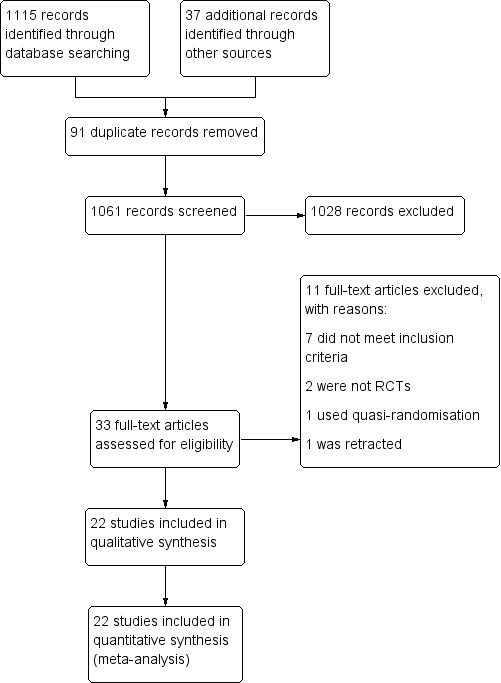
Study flow diagram
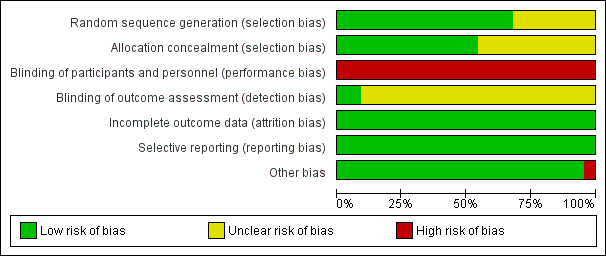
Risk of bias graph: review authors' judgements about each risk of bias item presented as percentages across all included studies.

Risk of bias summary: review authors' judgements about each risk of bias item for each included study.

Forest plot of comparison: 1 LOD vs medical interventions, outcome: 1.1 Menstrual regularity.
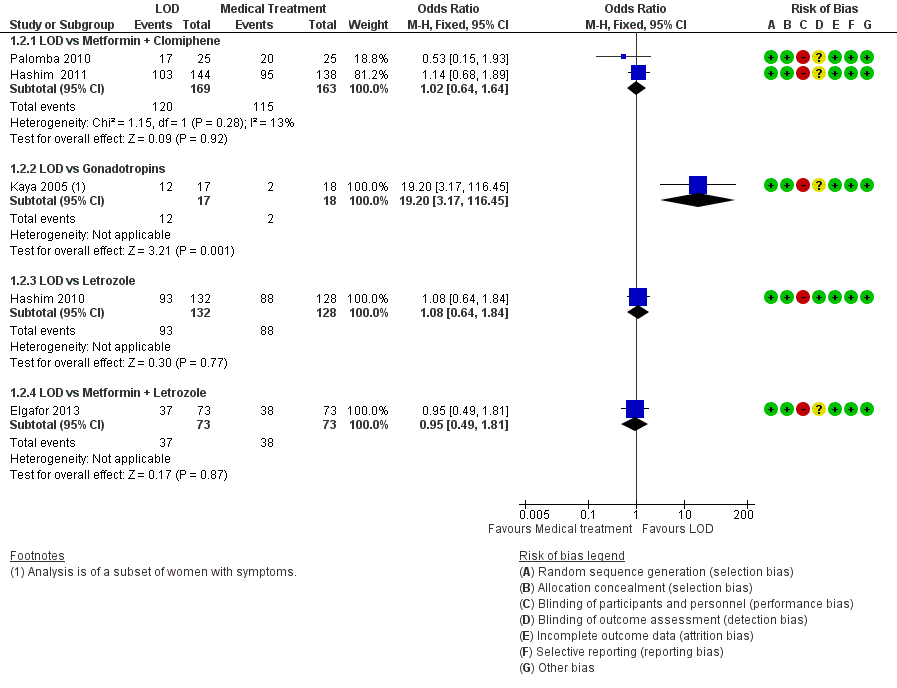
Forest plot of comparison: 1 LOD vs medical interventions, outcome: 1.2 Menstrual regularity.
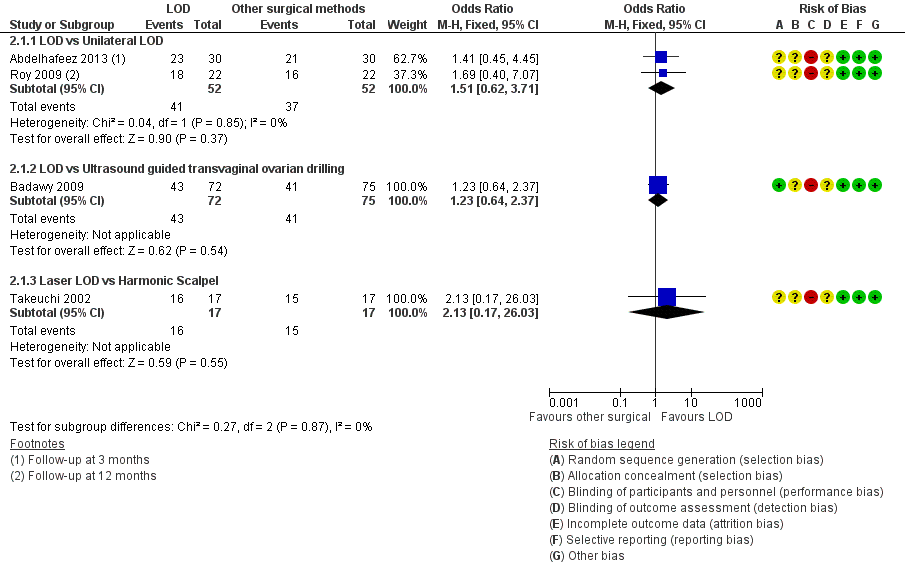
Forest plot of comparison: 2 LOD vs other surgical interventions, outcome: 2.1 Menstrual regularity.
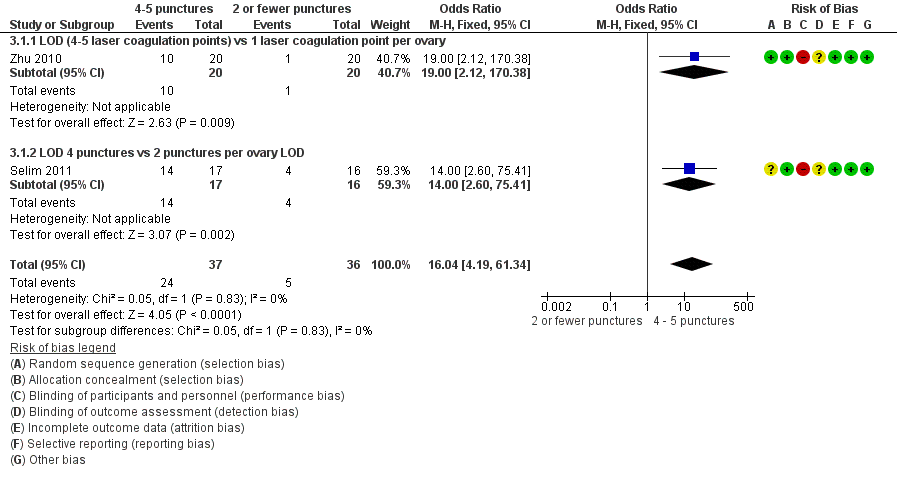
Forest plot of comparison: 3 LOD 4 ‐ 5 vs 2 or fewer punctures, outcome: 3.1 Menstrual regularity.

Forest plot of comparison: 4 LOD vs LOD variable energy, outcome: 4.1 Menstrual regularity.

Comparison 1 LOD vs medical interventions, Outcome 1 Menstrual regularity.

Comparison 1 LOD vs medical interventions, Outcome 2 Menstrual regularity.

Comparison 1 LOD vs medical interventions, Outcome 3 Improvement in androgenic symptoms (hirsutism/acne).
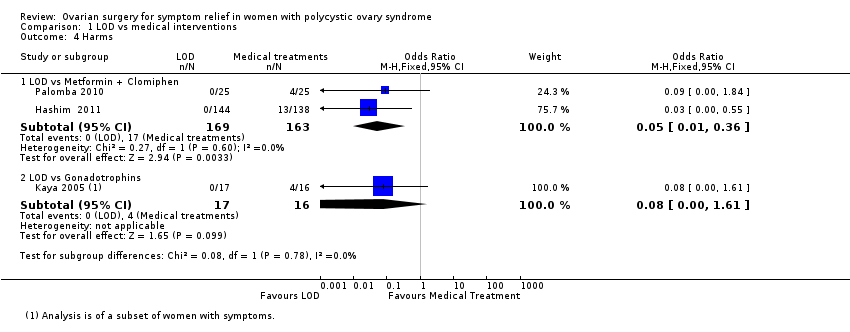
Comparison 1 LOD vs medical interventions, Outcome 4 Harms.

Comparison 1 LOD vs medical interventions, Outcome 5 BMI.

Comparison 1 LOD vs medical interventions, Outcome 6 Testosterone and free androgen index.

Comparison 1 LOD vs medical interventions, Outcome 7 Fasting Glucose:Insulin.

Comparison 2 LOD vs other surgical interventions, Outcome 1 Menstrual regularity.

Comparison 2 LOD vs other surgical interventions, Outcome 2 Improvement in androgenic symptoms (hirsutism/acne).

Comparison 2 LOD vs other surgical interventions, Outcome 3 Harms: Adhesions.

Comparison 2 LOD vs other surgical interventions, Outcome 4 Testosterone and free androgen index.
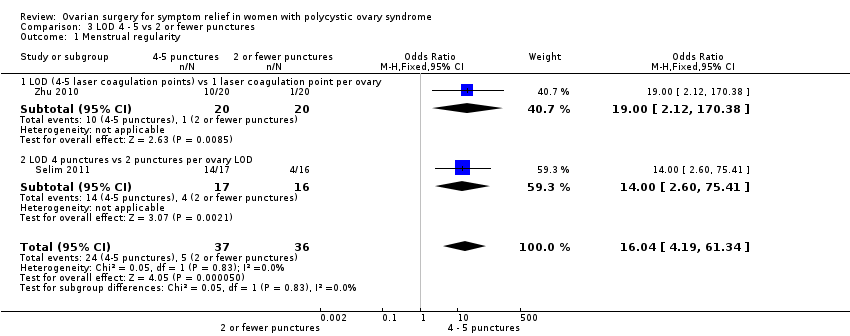
Comparison 3 LOD 4 ‐ 5 vs 2 or fewer punctures, Outcome 1 Menstrual regularity.

Comparison 3 LOD 4 ‐ 5 vs 2 or fewer punctures, Outcome 2 Testosterone and free androgen index.

Comparison 4 LOD vs LOD variable energy, Outcome 1 Menstrual regularity.

Comparison 4 LOD vs LOD variable energy, Outcome 2 Harms.

Comparison 4 LOD vs LOD variable energy, Outcome 3 BMI.

Comparison 4 LOD vs LOD variable energy, Outcome 4 Testosterone and free androgen index.

Comparison 4 LOD vs LOD variable energy, Outcome 5 Metabolic measures.
| LOD compared to medical interventions for symptom relief in women with polycystic ovary syndrome | ||||||
| Patient or population: Women with symptoms of PCOS | ||||||
| Outcomes | Relative effect | Anticipated absolute effects* (95% CI) | Quality of the evidence | What happens | ||
| Without LOD | With LOD | Difference | ||||
| Menstrual regularity at 6 months LOD vs metformin LOD vs metformin + clomiphene LOD vs gonadotropins LOD vs letrozole LOD vs metformin + letrozole | Findings inconsistent and data unsuitable for pooling | Not calculable | ⊕⊝⊝⊝ | |||
| OR 1.02 | 70.6% | 71.0% | 0.4% more | ⊕⊕⊝⊝ | ||
| OR 19.20 | 11.1% | 70.6% | 59.5% more | ⊕⊕⊝⊝ | ||
| OR 1.08 | 68.8% | 70.4% | 1.6% more | ⊕⊕⊝⊝ | ||
| OR 0.95 | 52.1% | 50.8% | 1.3% fewer | ⊕⊕⊝⊝ | ||
| Improvement in androgenic symptoms at 6 months (hirsutism/acne) ‐ LOD vs metformin | OR 1.00 | 79.4% | 79.4% | 0.0% fewer | ⊕⊕⊝⊝ | |
| Improvement in androgenic symptoms at 6 months (hirsutism/acne) ‐ LOD vs gonadotrophins | Acne: OR 3.20 (0.33 to 30.94) Hirsutism: OR 2.31, (0.22 to 23.89) | See comments | ⊕⊝⊝⊝VERY LOW 1, 4 | Acne: 4/29 without LOD, 1/21 with LOD Hirsutism: 3/29 without LOD, 1/21 with LOD | ||
| Harms: GI Upset at 6 months ‐ LOD vs metformin + clomiphene Harms: OHSS rates at 6 months ‐ LOD vs gonadotrophins | OR 0.05 | 10.4% | 0.6% | 9.9% fewer | ⊕⊕⊕⊝ | |
| OR 0.08 | 25.0% | 2.6% | 22.4% fewer | ⊕⊕⊝⊝ | ||
| *The risk in the intervention group (and its 95% confidence interval) is based on the mean risk in the comparison group and the relative effect of the intervention (and its 95% CI). | ||||||
| GRADE Working Group grades of evidence | ||||||
| 1Downgraded one level for serious risk of bias: Included studies not double‐blinded, and in some cases methods of randomization unclear. | ||||||
| LOD compared to other surgical interventions for symptom relief in women with polycystic ovary syndrome | ||||||
| Patient or population: Women with symptoms of PCOS | ||||||
| Outcomes | Relative effect | Anticipated absolute effects* (95% CI) | Quality of the evidence | What happens | ||
| Without LOD | With LOD | Difference | ||||
| Menstrual regularity ‐ LOD vs unilateral LOD | OR 1.51 | 71.2% | 78.8% | 7.7% more | ⊕⊕⊕⊝ | 1 study follow‐up at 3 months. 1 study follow‐up at 12 months |
| Menstrual regularity at 6 months ‐ LOD vs ultrasound‐guided transvaginal ovarian drilling | OR 1.23 | 54.7% | 59.7% | 5.1% more | ⊕⊕⊝⊝ | |
| Menstrual regularity at 12 months | OR 2.13 | 88.2% | 94.1% | 5.9% more | ⊕⊕⊝⊝ | Note control group is NdYAG Laser |
| Improvement in androgenic symptoms at 6 months (Acne) ‐ LOD vs USS guided | OR 0.84 (0.20 to 3.5) | 47.1% | 42.7% | 4.3% fewer | ⊕⊕⊝⊝ | |
| Improvement in androgenic symptoms at 6 months (Hirsutism) ‐ LOD vs USS‐guided | OR 1.09 | 40.0% | 42.1% (16.7 to 72.3) | 2.1% more (23.3 fewer to 32.3 more) | ⊕⊕⊝⊝ | |
| Harms: Adhesions at 6 months ‐ LOD vs THL | OR 0.10 | 59.3% | 12.7% | 46.6% fewer | ⊕⊝⊝⊝ | |
| *The risk in the intervention group (and its 95% confidence interval) is based on the assumed risk in the comparison group and the relative effect of the intervention (and its 95% CI). | ||||||
| GRADE Working Group grades of evidence | ||||||
| 1Downgraded one level for serious risk of bias: Included studies not double‐blinded or unclear allocation concealment or unclear randomization method. | ||||||
| LOD 4 ‐ 5 punctures compared to 2 or fewer punctures for symptom relief in women with polycystic ovary syndrome | ||||||
| Patient or population: Women with symptoms of PCOS | ||||||
| Outcomes | Relative effect | Anticipated absolute effects* (95% CI) | Quality of the evidence | What happens | ||
| Without LOD 4‐5 | With LOD 4‐5 | Difference | ||||
| Menstrual regularity at 6 months ‐ LOD 4 ‐ 5 coagulation points compared to 2 or fewer | OR 16.04 | 13.9% | 72.1% | 58.2% more | ⊕⊕⊝⊝ | |
| Menstrual regularity at 6 months ‐ LOD (4 ‐ 5 laser coagulation points) vs 1 laser coagulation point per ovary | OR 19.00 | 5.0% | 50.0% | 45.0% more | ⊕⊕⊝⊝ | |
| Menstrual regularity at 6 months ‐ LOD 4 punctures vs 2 punctures per ovary | OR 14.00 | 25.0% | 82.4% | 57.4% more | ⊕⊕⊝⊝ | |
| Improvement in androgenic symptoms | No data available | |||||
| Harms LOD 4 ‐ 5 versus fewer punctures | No data available | |||||
| *The risk in the intervention group (and its 95% confidence interval) is based on the assumed risk in the comparison group and the relative effect of the intervention (and its 95% CI). | ||||||
| GRADE Working Group grades of evidence | ||||||
| 1Downgraded one level for serious risk of bias: Included studies not double‐blinded or methods of randomization unclear. | ||||||
| LOD compared to LOD variable energy for symptom relief in women with polycystic ovary syndrome | ||||||
| Patient or population: Women with symptoms of PCOS | ||||||
| Outcomes | Relative effect | Anticipated absolute effects* (95% CI) | Quality of the evidence | What happens | ||
| Without LOD | With LOD | Difference | ||||
| Menstrual regularity at 6 months ‐ LOD vs adjusted thermal dose | OR 0.42 | 87.9% | 75.4% | 12.6% fewer | ⊕⊝⊝⊝ | |
| Menstrual regularity at 3 months ‐ LOD unipolar vs LOD bipolar | OR 1.00 | 90.0% | 90.0% | 0.0% fewer | ⊕⊝⊝⊝ | Groups had different metabolic characteristics at baseline |
| Improvement in androgenic symptoms | No data available | |||||
| Harms: Adhesions at 6 months | OR 0.96 | 28.6% | 27.7% | 0.8% fewer | ⊕⊝⊝⊝ VERY LOW1, 2 | Women that remained enrolled for second‐look laparoscopy |
| *The risk in the intervention group (and its 95% confidence interval) is based on the assumed risk in the comparison group and the relative effect of the intervention (and its 95% CI). | ||||||
| GRADE Working Group grades of evidence | ||||||
| 1Downgraded one level for serious risk of bias: Included studies not double‐blinded or unclear allocation concealment. | ||||||
| Outcome or subgroup title | No. of studies | No. of participants | Statistical method | Effect size |
| 1 Menstrual regularity Show forest plot | 2 | Odds Ratio (M‐H, Fixed, 95% CI) | Totals not selected | |
| 1.1 LOD vs Metformin alone | 2 | Odds Ratio (M‐H, Fixed, 95% CI) | 0.0 [0.0, 0.0] | |
| 2 Menstrual regularity Show forest plot | 5 | Odds Ratio (M‐H, Fixed, 95% CI) | Subtotals only | |
| 2.1 LOD vs Metformin + Clomiphene | 2 | 332 | Odds Ratio (M‐H, Fixed, 95% CI) | 1.02 [0.64, 1.64] |
| 2.2 LOD vs Gonadotropins | 1 | 35 | Odds Ratio (M‐H, Fixed, 95% CI) | 19.2 [3.17, 116.45] |
| 2.3 LOD vs Letrozole | 1 | 260 | Odds Ratio (M‐H, Fixed, 95% CI) | 1.08 [0.64, 1.84] |
| 2.4 LOD vs Metformin + Letrozole | 1 | 146 | Odds Ratio (M‐H, Fixed, 95% CI) | 0.95 [0.49, 1.81] |
| 3 Improvement in androgenic symptoms (hirsutism/acne) Show forest plot | 2 | Odds Ratio (M‐H, Fixed, 95% CI) | Totals not selected | |
| 3.1 LOD vs Metformin | 1 | Odds Ratio (M‐H, Fixed, 95% CI) | 0.0 [0.0, 0.0] | |
| 3.2 LOD vs Gonadotrophins | 1 | Odds Ratio (M‐H, Fixed, 95% CI) | 0.0 [0.0, 0.0] | |
| 4 Harms Show forest plot | 3 | Odds Ratio (M‐H, Fixed, 95% CI) | Subtotals only | |
| 4.1 LOD vs Metformin + Clomiphen | 2 | 332 | Odds Ratio (M‐H, Fixed, 95% CI) | 0.05 [0.01, 0.36] |
| 4.2 LOD vs Gonadotrophins | 1 | 33 | Odds Ratio (M‐H, Fixed, 95% CI) | 0.08 [0.00, 1.61] |
| 5 BMI Show forest plot | 2 | Mean Difference (IV, Fixed, 95% CI) | Totals not selected | |
| 5.1 LOD vs Metformin | 1 | Mean Difference (IV, Fixed, 95% CI) | 0.0 [0.0, 0.0] | |
| 5.2 LOD vs Metformin + Letrozole | 1 | Mean Difference (IV, Fixed, 95% CI) | 0.0 [0.0, 0.0] | |
| 6 Testosterone and free androgen index Show forest plot | 5 | Mean Difference (IV, Fixed, 95% CI) | Totals not selected | |
| 6.1 LOD vs Metformin | 2 | Mean Difference (IV, Fixed, 95% CI) | 0.0 [0.0, 0.0] | |
| 6.2 LOD vs GnRHa + OCP | 1 | Mean Difference (IV, Fixed, 95% CI) | 0.0 [0.0, 0.0] | |
| 6.3 LOD vs Metformin + Letrozole | 1 | Mean Difference (IV, Fixed, 95% CI) | 0.0 [0.0, 0.0] | |
| 6.4 LOD versus Rosiglitazone | 1 | Mean Difference (IV, Fixed, 95% CI) | 0.0 [0.0, 0.0] | |
| 7 Fasting Glucose:Insulin Show forest plot | 3 | Mean Difference (IV, Fixed, 95% CI) | Totals not selected | |
| 7.1 LOD vs Rosiglitazone | 1 | Mean Difference (IV, Fixed, 95% CI) | 0.0 [0.0, 0.0] | |
| 7.2 LOD vs Metformin | 1 | Mean Difference (IV, Fixed, 95% CI) | 0.0 [0.0, 0.0] | |
| 7.3 LOD vs Metformin + Letrozole | 1 | Mean Difference (IV, Fixed, 95% CI) | 0.0 [0.0, 0.0] | |
| Outcome or subgroup title | No. of studies | No. of participants | Statistical method | Effect size |
| 1 Menstrual regularity Show forest plot | 4 | Odds Ratio (M‐H, Fixed, 95% CI) | Subtotals only | |
| 1.1 LOD vs Unilateral LOD | 2 | 104 | Odds Ratio (M‐H, Fixed, 95% CI) | 1.51 [0.62, 3.71] |
| 1.2 LOD vs Ultrasound guided transvaginal ovarian drilling | 1 | 147 | Odds Ratio (M‐H, Fixed, 95% CI) | 1.23 [0.64, 2.37] |
| 1.3 Laser LOD vs Harmonic Scalpel | 1 | 34 | Odds Ratio (M‐H, Fixed, 95% CI) | 2.13 [0.17, 26.03] |
| 2 Improvement in androgenic symptoms (hirsutism/acne) Show forest plot | 1 | Odds Ratio (M‐H, Fixed, 95% CI) | Totals not selected | |
| 2.1 Hirsutism | 1 | Odds Ratio (M‐H, Fixed, 95% CI) | 0.0 [0.0, 0.0] | |
| 2.2 Acne | 1 | Odds Ratio (M‐H, Fixed, 95% CI) | 0.0 [0.0, 0.0] | |
| 3 Harms: Adhesions Show forest plot | 1 | Odds Ratio (M‐H, Fixed, 95% CI) | Totals not selected | |
| 4 Testosterone and free androgen index Show forest plot | 6 | Mean Difference (IV, Fixed, 95% CI) | Totals not selected | |
| 4.1 LOD vs Ultrasound guided transvaginal ovarian drilling | 1 | Mean Difference (IV, Fixed, 95% CI) | 0.0 [0.0, 0.0] | |
| 4.2 LOD versus mini laparoscopy with sedation | 1 | Mean Difference (IV, Fixed, 95% CI) | 0.0 [0.0, 0.0] | |
| 4.3 LOD vs unilateral LOD | 3 | Mean Difference (IV, Fixed, 95% CI) | 0.0 [0.0, 0.0] | |
| 4.4 Laser LOD vs Harmonic Scalpel | 1 | Mean Difference (IV, Fixed, 95% CI) | 0.0 [0.0, 0.0] | |
| Outcome or subgroup title | No. of studies | No. of participants | Statistical method | Effect size |
| 1 Menstrual regularity Show forest plot | 2 | 73 | Odds Ratio (M‐H, Fixed, 95% CI) | 16.04 [4.19, 61.34] |
| 1.1 LOD (4‐5 laser coagulation points) vs 1 laser coagulation point per ovary | 1 | 40 | Odds Ratio (M‐H, Fixed, 95% CI) | 19.0 [2.12, 170.38] |
| 1.2 LOD 4 punctures vs 2 punctures per ovary LOD | 1 | 33 | Odds Ratio (M‐H, Fixed, 95% CI) | 14.0 [2.60, 75.41] |
| 2 Testosterone and free androgen index Show forest plot | 2 | Mean Difference (IV, Fixed, 95% CI) | Subtotals only | |
| 2.1 LOD 4‐5 punctures vs 2 or fewer punctures (Testosterone) | 2 | 73 | Mean Difference (IV, Fixed, 95% CI) | ‐0.90 [‐1.12, ‐0.68] |
| 2.2 LOD 4 punctures vs 2 punctures (FAI) | 1 | 33 | Mean Difference (IV, Fixed, 95% CI) | ‐1.5 [‐3.21, 0.21] |
| Outcome or subgroup title | No. of studies | No. of participants | Statistical method | Effect size |
| 1 Menstrual regularity Show forest plot | 2 | Odds Ratio (M‐H, Fixed, 95% CI) | Totals not selected | |
| 1.1 LOD vs Adjusted thermal dose | 1 | Odds Ratio (M‐H, Fixed, 95% CI) | 0.0 [0.0, 0.0] | |
| 1.2 LOD unipolar vs LOD bipolar | 1 | Odds Ratio (M‐H, Fixed, 95% CI) | 0.0 [0.0, 0.0] | |
| 2 Harms Show forest plot | 1 | Odds Ratio (M‐H, Fixed, 95% CI) | Totals not selected | |
| 3 BMI Show forest plot | 1 | Mean Difference (IV, Fixed, 95% CI) | Totals not selected | |
| 4 Testosterone and free androgen index Show forest plot | 2 | Mean Difference (IV, Fixed, 95% CI) | Totals not selected | |
| 4.1 LOD vs Adjusted thermal dose | 1 | Mean Difference (IV, Fixed, 95% CI) | 0.0 [0.0, 0.0] | |
| 4.2 LOD unipolar vs LOD bipolar | 1 | Mean Difference (IV, Fixed, 95% CI) | 0.0 [0.0, 0.0] | |
| 5 Metabolic measures Show forest plot | 1 | Mean Difference (IV, Fixed, 95% CI) | Totals not selected | |
| 5.1 LOD (unipolar) vs bipolar | 1 | Mean Difference (IV, Fixed, 95% CI) | 0.0 [0.0, 0.0] | |

